| Revision as of 06:32, 7 April 2021 view sourceHypnôs (talk | contribs)Extended confirmed users3,714 editsNo edit summaryTag: Visual edit← Previous edit | Revision as of 08:33, 7 April 2021 view source Hypnôs (talk | contribs)Extended confirmed users3,714 editsNo edit summaryNext edit → | ||
| Line 397: | Line 397: | ||
| * {{cite book|last=Edwards|first=I.E.S.|author-link=I. E. S. Edwards|title=The Pyramids of Egypt |publisher=Max Parrish |year=1986 |orig-year=1962}} | * {{cite book|last=Edwards|first=I.E.S.|author-link=I. E. S. Edwards|title=The Pyramids of Egypt |publisher=Max Parrish |year=1986 |orig-year=1962}} | ||
| * {{cite book |last1=El Daly |first1=Okasha |title=Egyptology: The Missing Millennium : Ancient Egypt in Medieval Arabic Writings |date=2005 |publisher=Psychology Press |isbn=978-1-84472-063-7 |url=https://books.google.com/books?id=rdI96px90kUC |access-date=27 March 2021 |language=en}} | * {{cite book |last1=El Daly |first1=Okasha |title=Egyptology: The Missing Millennium : Ancient Egypt in Medieval Arabic Writings |date=2005 |publisher=Psychology Press |isbn=978-1-84472-063-7 |url=https://books.google.com/books?id=rdI96px90kUC |access-date=27 March 2021 |language=en}} | ||
| * {{cite book |last1=Greaves |first1=John |title=Pyramidographia: or, a Description of the pyramids in Egypt |url=https://digi.ub.uni-heidelberg.de/diglit/greaves1752 |access-date=7 April 2021 |language=en |date=1752}} | |||
| * {{cite journal|last=Haase |first=Michael |title=Der Serviceschacht der Cheops-Pyramide. Bemerkungen zur Konstruktion des Verbindungsschachtes zwischen Großer Galerie und absteigendem Korridor. |journal=Sokar |volume=9 |year=2004 |pages=12–17 |issn=1438-7956 |url=http://giza.fas.harvard.edu/pubdocs/542/full/}} | * {{cite journal|last=Haase |first=Michael |title=Der Serviceschacht der Cheops-Pyramide. Bemerkungen zur Konstruktion des Verbindungsschachtes zwischen Großer Galerie und absteigendem Korridor. |journal=Sokar |volume=9 |year=2004 |pages=12–17 |issn=1438-7956 |url=http://giza.fas.harvard.edu/pubdocs/542/full/}} | ||
| * {{cite book |last1=Hassan |first1=Selim |title=Excavations at Gîza 10: 1938-39. The Great Pyramid of Khufu and its Mortuary Chapel |url=http://giza.fas.harvard.edu/pubdocs/246/full/ |access-date=7 April 2021 |language=en |date=1960}} | |||
| * {{cite book|last1=Hawass|first1=Zahi|last2=Senussi|first2=Ashraf|year=2008|title=Old Kingdom Pottery from Giza|publisher=Supreme Council of Antiquities|isbn=978-977-305-986-6}} | * {{cite book|last1=Hawass|first1=Zahi|last2=Senussi|first2=Ashraf|year=2008|title=Old Kingdom Pottery from Giza|publisher=Supreme Council of Antiquities|isbn=978-977-305-986-6}} | ||
| * {{Cite book| publisher = Columbia University Press| last = Ibn al-Nadim| others = Bayard Dodge (trans.)| title = The Fihrist of al-Nadim: a tenth-century survey of muslim culture| location = New York City, NY| date = 1970}} | * {{Cite book| publisher = Columbia University Press| last = Ibn al-Nadim| others = Bayard Dodge (trans.)| title = The Fihrist of al-Nadim: a tenth-century survey of muslim culture| location = New York City, NY| date = 1970}} | ||
| Line 422: | Line 424: | ||
| * {{cite book|last=Smith|first=Philip|date=1873|title=A History of the Ancient World|publisher=John Murray|location=London|edition=4|volume=1}} | * {{cite book|last=Smith|first=Philip|date=1873|title=A History of the Ancient World|publisher=John Murray|location=London|edition=4|volume=1}} | ||
| * {{cite book|last=Stocks|first=Denys Allen|title=Experiments in Egyptian archaeology: stoneworking technology in ancient Egypt|year=2003|publisher=Routledge|isbn=978-0-415-30664-5|url=https://books.google.com/books?id=oLDuHvQODoIC}} | * {{cite book|last=Stocks|first=Denys Allen|title=Experiments in Egyptian archaeology: stoneworking technology in ancient Egypt|year=2003|publisher=Routledge|isbn=978-0-415-30664-5|url=https://books.google.com/books?id=oLDuHvQODoIC}} | ||
| * {{Cite book| last = Tallet| first = Pierre| title = Les Papyrus de la Mer Rouge I: Le Journal de Merer (Mifao) (Arabic, English and French Edition)| isbn=978-2724707069| date = 2017}} | |||
| * {{Cite book| publisher = Harper & Row| last = Tompkins| first = Peter| title = Secrets of the Great Pyramid| location = New York City, NY| date = 1971}} | * {{Cite book| publisher = Harper & Row| last = Tompkins| first = Peter| title = Secrets of the Great Pyramid| location = New York City, NY| date = 1971}} | ||
| * {{Cite book|title=Egypt: How a lost civilization was rediscovered|first=Joyce|last=Tyldesley|year=2007|isbn=978-0-563-52257-7|publisher=BBC Books}} | * {{Cite book|title=Egypt: How a lost civilization was rediscovered|first=Joyce|last=Tyldesley|year=2007|isbn=978-0-563-52257-7|publisher=BBC Books}} | ||
Revision as of 08:33, 7 April 2021
Largest pyramid in the Giza Necropolis, Egypt "Great Pyramid" redirects here. For the pyramid in Mexico, see Great Pyramid of Cholula.
| The Great Pyramid of Giza | |||||||||||||||
|---|---|---|---|---|---|---|---|---|---|---|---|---|---|---|---|
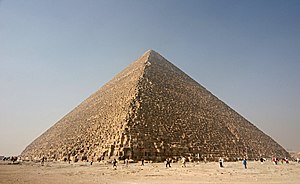 The Great Pyramid of Giza in March 2005 The Great Pyramid of Giza in March 2005 | |||||||||||||||
| Khufu | |||||||||||||||
| Coordinates | 29°58′45″N 31°08′03″E / 29.97917°N 31.13417°E / 29.97917; 31.13417 | ||||||||||||||
| Ancient name |
ꜣḫt Ḫwfw Akhet Khufu Khufu's Horizon | ||||||||||||||
| Constructed | c. 2580–2560 BC (4th dynasty) | ||||||||||||||
| Type | True pyramid | ||||||||||||||
| Material | Limestone, granite | ||||||||||||||
| Height |
| ||||||||||||||
| Base | Length of 230.34 metres (756 ft) or 440 Egyptian Royal cubits | ||||||||||||||
| Volume | 2,583,283 cubic metres (91,227,778 cu ft) | ||||||||||||||
| Slope | 51°50'40" or Seked of 5+1/2 palms Building details | ||||||||||||||
| Record height | |||||||||||||||
| Tallest in the world from 2560 BC to 1311 AD | |||||||||||||||
| Surpassed by | Lincoln Cathedral | ||||||||||||||
| UNESCO World Heritage Site | |||||||||||||||
| Part of | Memphis and its Necropolis – the Pyramid Fields from Giza to Dahshur | ||||||||||||||
| Criteria | Cultural: i, iii, vi | ||||||||||||||
| Reference | 86-002 | ||||||||||||||
| Inscription | 1979 (3rd Session) | ||||||||||||||
The Great Pyramid of Giza (also known as the Pyramid of Khufu or the Pyramid of Cheops) is the oldest and largest of the pyramids in the Giza pyramid complex bordering present-day Giza in Greater Cairo, Egypt. It is the oldest of the Seven Wonders of the Ancient World, and the only one to remain largely intact.
Egyptologists conclude that the pyramid was built as a tomb for the Fourth Dynasty Egyptian pharaoh Khufu and estimate that it took around 27 years to build, being completed circa 2560 BC.
Initially standing at 146.5 metres (481 feet), the Great Pyramid was the tallest man-made structure in the world for more than 3,800 years. The base was measured to be about 230.3 metres (755.6 ft) square, giving a volume of roughly 2.6 million cubic metres (92 million cubic feet), which includes an internal hillock.
It was originally covered by white limestone casing stones that formed a smooth outer surface; The pyramid was dismantled and used as a quarry, mostly in the middle ages, which lowered its height to the present 137 metres (449.5 ft). What is seen today is the underlying core structure, although a few casing stones are still In situ.
The Great Pyramid was built by quarrying an estimated 2.3 million large stones weighing 6 million tonnes total, which were dragged into position. Many varying scientific and alternative hypotheses attempt to explain the exact construction techniques. Primarily local limestone from the Giza Plateau was used. Other blocks were imported by boat down the Nile: White limestone from Tura for the casing, and granite blocks from Aswan, weighing up to 80 tonnes, for the King's Chamber structure.
The dimensions of the pyramid, expressed in ancient Egyptian units of measurement, were 280 cubits high, a base length of 440 cubits, with a Seked of 5+1/2 palms (a slope of 51°50'40").
There are three known chambers inside the Great Pyramid. The lowest chamber was cut into the bedrock upon which the pyramid was built but remained unfinished. The so-called Queen's Chamber and King's Chamber, that contains a granite sarcophagus, are higher up, within the pyramid structure. The funerary complex around the pyramid included two mortuary temples connected by a causeway (one close to the pyramid and one near the Nile), tombs for the immediate family and court of Khufu, including three smaller pyramids for Khufu's wives, an even smaller "satellite" pyramid and five buried solar barges.
Khufu's vizier, Hemiunu (also called Hemon), is believed by some to be the architect of the Great Pyramid.
Historiographical record
Classical antiquity
Herodotus

The ancient Greek historian Herodotus, writing in the 5th century BC, is one of the first major authors to mention the pyramid. In the second book of his work The Histories, he discusses the history of Egypt and the Great Pyramid. This report was created more than 2000 years after the structure was built, meaning that Herodotus obtained his knowledge mainly from a variety of indirect sources, including officials and priests of low rank, local Egyptians, Greek immigrants, and Herodotus's own interpreters. Accordingly, his explanations present themselves as a mixture of comprehensible descriptions, personal descriptions, erroneous reports, and fantastical legends; as such, many of the speculative errors and confusions about the monument can be traced back to Herodotus and his work.
Herodotus writes that the pyramid was built by Khufu (Hellenized as Cheops), whom he mistakenly argues ruled sometime after Ramses III of the Twentieth Dynasty. Khufu, Herodotus claims, was a tyrannical king, which probably shows the view of the Greeks that such buildings can only come about through cruel exploitation of the people. Herodotus further writes that on the orders of Khufu, 100,000 workers worked on the building in three-month shifts, taking 20 years to build. In the first ten years, a wide causeway was erected, which, according to Herodotus, was almost as impressive as the construction of the pyramids themselves, since it was nearly 1 kilometre (0.62 mi) long and twenty yards wide, and elevated at its highest to a height of sixteen yards, and it is all of stone polished and carved with figures. In addition, underground chambers were made on the hill whereon the pyramids stand, meant to be burial places for Khufu himself, which were encompassed with water which a channel brought in from the Nile. Herodotus later states that at the Pyramid of Khafre (next to the Great Pyramid) the Nile flows through a built passage to an island in which Khufu is buried. (Hawass interprets this to be a reference to the "Osiris Shaft" which is located at the causeway of Khafre south of the Great Pyramid.)
Herodotus also described an inscription on the outside of the pyramid which, according to his translators, indicated the amount of radishes, garlic and onions that the workers would have eaten while working on the pyramid. This could be a note of restoration work that Khaemweset, son of Rameses II, had carried out. Apparently, Herodotus companions and interpreters could not read the hieroglyphs or deliberately gave him false information.
Diodorus Siculus
Between 60-56 BC, the ancient Greek historian Diodorus Siculus visited Egypt and later dedicated the first book of his Bibliotheca historica to the land, its history, and its monuments, including the Great Pyramid. Diodorus's work was inspired by historians of the past, but he also distanced himself from Herodotus, who Diodorus claimed described only "marvelous tales and the invention of myths". Diodorus presumably drew his knowledge from the lost work of Hecataeus of Abdera, and like Herodotus, he also places the builder of the pyramid, "Chemmis," after Ramses III. According to his report, neither Chemmis (Khufu) nor Cephren (Khafre) were buried in their pyramids, but rather in secret places, for fear that the people ostensibly forced to build the structures would seek out the bodies for revenge; with this assertion, Diodorus strengthened the connection between pyramid building and slavery.
According to Diodorus, the cladding of the pyramid was still in excellent condition at the time, whereas the uppermost part of the pyramid was formed by a platform six cubits wide (approx. 3 m). About the construction of the pyramid he notes that it was built with the help of ramps since no lifting tools had yet been invented. Nothing was left of the ramps, as they were removed after the pyramids were completed. He estimated the number of workers who were necessary to erect the Great Pyramid at 360,000 and the construction time at 20 years. Similar to Herodotus, Diodorus also claims that the side of the pyramid is inscribed with writing that " forth vegetables and purgatives for the workmen there were paid out over sixteen hundred talents."
Strabo
The Greek geographer, philosopher, and historian Strabo visited Egypt around 25 BC, shortly after Egypt was annexed by the Romans. In his work Geographica, the writer argued that the pyramids were the burial place of kings, but he does mention which king was buried in the structure. Strabo also mentions: "At a moderate height in one of the sides is a stone, which may be taken out; when that is removed, there is an oblique passage to the tomb." This statement has generated much speculation, as it suggests that the pyramid could be entered at this time. I. E. S. Edwards later suggested that the pyramid was entered by robbers after the end of the Old Kingdom and sealed and then reopened more than once until Strabo's door was added sometime before 25 BC, potentially by the Saite pharaohs (664–525 BC). Edwards adds: "If this highly speculative surmise be correct, it is also necessary to assume either that the existence of the door was forgotten or that the entrance was again blocked with facing stones", in order to explain why al-Ma'mun could not find the entrance in the ninth century AD. Scholars such as Gaston Maspero and Flinders Petrie have noted that evidence for a similar door has been found at the Bent Pyramid of Dashur.
Pliny the Elder

The Roman writer Pliny the Elder, writing in the first century AD, argued that the Great Pyramid had been raised either "to prevent the lower classes from remaining unoccupied", or as a measure to prevent the pharaoh's riches from falling into the hands of his rivals or successors. Pliny does not speculate as to the pharaoh in question, explicitly noting that "accident consigned to oblivion the names of those who erected such stupendous memorials of their vanity". Pliny echoes previous authors, such as Diodorus Siculus, stating it took 20 years and 360,000 men to build. Pliny further contends that the structure was built by stone hauled from "Arabia". In pondering how the stones could be transported to such a vast height he gives two explanations: That either vast mounds of nitre and salt were heaped up against the pyramid which were then melted away with water redirected from the river. Or that "bridges" were constructed, their bricks afterwards distributed for erecting houses of private individuals, arguing that the level of the river is too low for canals to ever bring water up to the pyramid. Pliny also recounts how "in the interior of the largest Pyramid there is a well, eighty-six cubits deep, which communicates with the river, it is thought". Further, he describes a method discovered by Thales of Miletus for ascertaining the pyramid's height by measuring its shadow.
Late antiquity and the Middle Ages
Further information: Joseph's GranariesDuring late antiquity, a misinterpretation of the pyramids as " Joseph's granary " began to gain in popularity. The first textual evidence of this connection is found in the travel narratives of the female Christian pilgrim Egeria, who records that on her visit between 381-84 CE, "in the twelve-mile stretch between Memphis and Babylonia are many pyramids, which Joseph made in order to store corn." Ten years later the usage is confirmed in the anonymous travelogue of seven monks that set out from Jerusalem to visit the famous ascetics in Egypt, wherein they report that they "saw Joseph's granaries, where he stored grain in biblical times." This late 4th century usage is further confirmed in the geographical treatise Cosmographia , written by Julius Honorius around 376 AD, which explains that the Pyramids were called the "granaries of Joseph" (horrea Ioseph). This reference from Julius is important, for it indicates that the identification was starting to spread out from pilgrim's travelogues. In 530 AD, Stephanos of Byzantium added more to this idea when he wrote in his Ethnica that the word "pyramid" was connected to the Greek word πυρός (puros), meaning wheat.

In the seventh century AD, the Rashidun Caliphate conquered Egypt, ending several centuries of Romano-Byzantine rule. A few centuries later, in 820 AD, the Abbasid Caliph Al-Ma'mun (AD 786–833) is said to have tunneled into the side of the structure and discovered the ascending passage and its connecting chambers. It was around this time that a Coptic legend gained popularity that claimed the antediluvian king Surid Ibn Salhouk was the one who built the Pyramid. One legend in particular relates how, three hundred years prior to the Great Flood, Surid had a terrifying dream of the world's end, and so he ordered the construction of the pyramids so that they might house all the knowledge of Egypt and survive into the present. The most notable account of this legend was given by Al-Masudi (AD 896-956) in his Akbar al-zaman alongside imaginative tales about the pyramid, such as the story of a man who fell three hours down the pyramid's well and the tale of an expedition that discovered bizarre finds in the structure's inner chambers. The Akbar al-zaman also contains a report of Al-Ma'mun's entry into the pyramid, although the author adds that Al-Ma'mun discovered a vessel containing a thousand coins, which just so happened to account for the cost of opening the pyramid. (Some speculate that this story is true, but that the coins were planted by Al-Ma'mun to appease his workers, who were likely frustrated that they had found no treasure.)
In 987 AD, the Arab bibliographer Ibn al-Nadim relates a fantastical tale in his Al-Fihrist about a man who journeyed into the main chamber of a pyramid, which Bayard Dodge argues is the Great Pyramid. According to al-Nadim, the person in question saw a statue of a man holding a tablet and a woman holding a mirror. Between the statues was supposedly a "stone vessel a gold cover." Inside the vessel was "something like pitch," and when the explorer reached into the vessel "a gold receptacle happened to be inside." The receptacle, when taken from the vessel, was filled with "fresh blood," which quickly dried up. Ibn al-Nadim's work also claims that the bodies of a man and woman were discovered inside the Pyramid in "best possible state of preservation." The author al-Kaisi, in his work the Tohfat Alalbab, retells the story of Al-Ma'mun's entry but notes that Al-Ma'mun also discovered "an image of a man in green stone," which when opened revealed a body dressed in jewel-encrusted gold armor. al-Kaisi's claims to have seen the case from which the body was taken, and asserts that it was located at the king's palace in Cairo. al-Kaisi also writes that he himself entered into the Pyramid and discovered myriad preserved bodies.
The Arab polymath Abd al-Latif al-Baghdadi (1163-1231) studied the pyramid with great care, and in his Account of Egypt, he praises them of works of engineering genius. In addition to measuring the structure (and the other pyramids at Giza), al-Baghdadi also writes that the structures were surely tombs, although he thought it was used for the burial of Agathodaimon or Hermes. al-Baghdadi also discussed whether the pyramid pre-dated the Great flood as described in Genesis, and he even briefly entertained the idea that it was a pre-Adamic construction. A few centuries later, the Islamic historian Al-Maqrizi (1364-1442) compiled up lore about the Pyramid in his Al-Khitat. In addition to further assertions that Al-Ma'mun breached the pyramid in 820 AD, Al-Maqrizi's work also discusses the sarcophagus in the coffin chambers, explicitly noting that the structure was a grave. By the close of the Middle Ages, the Great Pyramid had gained a reputation as a haunted structure. Others feared the structure because the Pyramid was home to animals like bats.
Construction
Materials
The Great Pyramid consists of an estimated 2.3 million blocks. Approximately 5.5 million tonnes of limestone, 8,000 tonnes of granite, and 500,000 tonnes of mortar were used in the construction.
Most of the blocks were quarried at Giza just south of the pyramid, an area now known as the Central Field.
The white limestone used for the casing originated from Tura (10 km (6.2 mi) south of Giza) and was transported by boat down the Nile. In 2013, rolls of papyrus called the Diary of Merer were discovered, written by a supervisor of the deliveries of limestone and other construction materials from Tura to Giza in the last known year of Khufu's reign.
The granite stones in the pyramid were transported from Aswan, more than 900 km (560 mi) away. The largest, weighing 25 to 80 tonnes, form the roofs of the "King's chamber" and the "relieving chambers" above it. Ancient Egyptians cut stone into rough blocks by hammering grooves into natural stone faces, inserting wooden wedges, then soaking these with water. As the water was absorbed, the wedges expanded, breaking off workable chunks. Once the blocks were cut, they were carried by boat either up or down the Nile River to the pyramid.
Construction theories

Many alternative, often contradictory, theories have been proposed regarding the pyramid's construction techniques. The Greeks believed that slave labour was used, but modern discoveries made at nearby workers' camps associated with construction at Giza suggest that it was built instead by thousands of conscript laborers.
One mystery of the pyramid's construction is its planning. John Romer suggests that they used the same method that had been used for earlier and later constructions, laying out parts of the plan on the ground at a 1-to-1 scale. He writes that "such a working diagram would also serve to generate the architecture of the pyramid with precision unmatched by any other means". He also argues for a 14-year time-span for its construction. A modern construction management study, in association with Mark Lehner and other Egyptologists, estimated that the total project required an average workforce of about 13,200 people and a peak workforce of roughly 40,000. The authors of the study used critical path analysis methods, which suggest that the Great Pyramid could have been completed from start to finish in approximately 10 years.
The basalt blocks of the pyramid temple show "clear evidence" of having been cut with some kind of saw with an estimated cutting blade of 15 feet (4.6 m) in length. Romer suggests that this "super saw" may have had copper teeth and weighed up to 300 pounds (140 kg). He theorizes that such a saw could have been attached to a wooden trestle and possibly used in conjunction with vegetable oil, cutting sand, emery or pounded quartz to cut the blocks, which would have required the labour of at least a dozen men to operate it.
Surveys and Design
The first precise measurements of the pyramid were made by Egyptologist Sir Flinders Petrie in 1880–82 and published as The Pyramids and Temples of Gizeh. Many of the casing-stones and inner chamber blocks of the Great Pyramid fit together with extremely high precision. Based on measurements taken on the north-eastern casing stones, the mean opening of the joints is only 0.5 millimetres (0.020 in) wide.
The accuracy of the pyramid's workmanship is such that the four sides of the base have an average error of only 58 millimetres (2.3 inches) in length. The base is horizontal and flat to within 21 mm (0.8 in). The sides of the square base are closely aligned to the four cardinal compass points, 3 Minutes and 6 seconds of arc off true north, not magnetic north, and the finished base was squared to a mean corner error of only 12 seconds of arc.
The completed design dimensions, as suggested by Petrie's survey and subsequent studies, are estimated to have originally been 280 Egyptian Royal cubits high by 440 cubits long at each of the four sides of its base. Ancient Egyptians used Seked - how much run for one cubit of rise - to describe slopes. For the Great Pyramid a Seked of 5+1/2 palms was used, or a measurement of 14 up to 11 in.
Some Egyptologists suggest this slope was chosen because the ratio of perimeter to height (1760/280 cubits) equates to 2π to an accuracy of better than 0.05 percent (corresponding to the well-known approximation of π as 22/7). Verner wrote, "We can conclude that although the ancient Egyptians could not precisely define the value of π, in practice they used it". Petrie concluded: "but these relations of areas and of circular ratio are so systematic that we should grant that they were in the builder's design". Others have argued that the ancient Egyptians had no concept of pi and would not have thought to encode it in their monuments and that the observed pyramid slope may be based on the seked choice alone.
Exterior
Casing
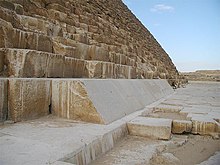
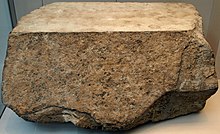
At completion, the Great Pyramid was cased entirely in white limestone. Precisely worked blocks were placed in horizontal layers and carefully fitted together with mortar, their outward faces cut at a slope and smoothed to a high degree. Together they created four uniform surfaces, angled at 51°50'40" (a Seked of 5+1/2 palms). Unfinished casing blocks of the pyramids of Menkaure and Henutsen at Giza suggest that the front faces were smoothed only after the stones were laid, with chiseled seams marking correct positioning and where the superfluous rock would have to be trimmed off.
The height of the horizontal layers is not uniform but varies considerably. The highest of the 203 remaining courses are towards the bottom. The first layer being the tallest at 1.49 metres (4.9 ft). Towards the top, layers tend to be only slightly over 1 cubit in height 0.52 metres (1.7 ft). An irregular pattern is noticeable when looking at the sizes in sequence, where layer height declines steadily only to rise sharply again.
So-called "backing stones" supported the casing which were (unlike core blocks) precisely dressed as well and bound to the casing with mortar. Nowadays, these stones give the structure its visible appearance, following the dismantling of the pyramid in the middle ages. In 1303 AD, a massive earthquake had loosened many of the outer casing stones, which were said to have been carted away by Bahri Sultan An-Nasir Nasir-ad-Din al-Hasan in 1356 for use in nearby Cairo. Many more casing stones were removed from the site by Muhammad Ali Pasha in the early 19th century to build the upper portion of his Alabaster Mosque in Cairo, not far from Giza. Later explorers reported massive piles of rubble at the base of the pyramids left over from the continuing collapse of the casing stones, which were subsequently cleared away during continuing excavations of the site. Today a few of the casing stones from the lowest course can be seen in situ on each side, with the best preserved on the north below the entrances, excavated by Vyse in 1837.
The mortar was chemically analyzed and contains organic inclusions (mostly coal), samples of which were radiocarbon dated to circa 2,800 BC. It has been theorized that the mortar enabled the masons to set the stones exactly by providing a level bed.
It has been suggested that some or all of the casing stones were cast in place, rather than quarried and moved, yet archaeological evidence and petrographic analysis indicate this was not the case.
Petrie noted in 1880 that the sides of the pyramid, as we see them today, are "very distinctly hollowed" and that "each side has a sort of groove specially down the middle of the face", which he reasoned was a result of increased casing thickness in these areas. A laser scanning survey in 2005 confirmed the existence of the anomalies, which can be, to some degree, attributed to damaged and removed stones. Under certain lighting conditions and with image enhancement the faces can appear to be split, leading to speculation that the pyramid had been intentionally constructed eight-sided.
Pyramidion and Missing Tip
The pyramid was once topped by a capstone, a Pyramidion. The material it was made from is subject to much speculation, Limestone, granite or basalt are commonly proposed, in popular culture often made of solid gold or gilded. All the 4th dynasty pyramidia (of the Red Pyramid, Satellite Pyramid of Khufu (G1-d) and Queen's Pyramid of Menkaure (G3-a)) known are of white limestone and were not gilded. Only from the 5th dynasty onward is there evidence of gilded capstones, for instance a scene on the causeway of the Sahure speaks of the "white gold pyramidion of the pyramid ‘Sahure’s Soul Shines".
The Great Pyramid's pyramidion was already lost in antiquity, as Pliny the Elder and later authors report of a platform on the summit. A mast was installed on the summit by the astronomer David Gill in 1874 (returning from observing a rare Venus transit) probably to help determine the original height of the Great Pyramid. It is still in place to this day. Today the pyramid is about 8 metres (26 ft) shorter than it was when intact, with about 1,000 tonnes of material missing from the top.
Interior
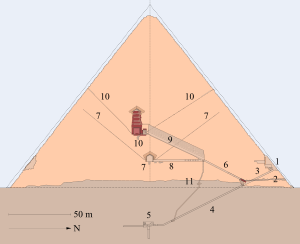
| 1. Original entrance |
| 2. Robbers' Tunnel (tourist entrance) |
| 3, 4. Descending Passage |
| 5. Subterranean Chamber |
| 6. Ascending Passage |
| 7. Queen's Chamber & its "air-shafts" |
| 8. Horizontal Passage |
| 9. Grand Gallery |
| 10. King's Chamber & its "air-shafts" |
| 11. Grotto & Well Shaft |
The internal structure consists of three main chambers (the King's-, Queen's- and Subterranean Chamber), the Grand Gallery and various corridors and shafts.
There are two entrances into the pyramid, the original and a forced passage, which both meet at a junction. From there, one passage descends into the Subterranean Chamber, the other ascends to the Grand Gallery. From the beginning of the gallery three paths can be taken:
- a vertical shaft that leads down, past a grotto, to meet the descending passage,
- a horizontal corridor leading to the Queen's Chamber,
- and the path up the gallery itself to the King's Chamber that contains the sarcophagus.
Both the King's and Queen's chamber have a pair of small "air-shafts". Above the King's chamber are a series of five Relieving Chambers.
Entrances
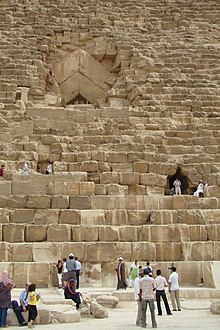
Original Entrance
The original entrance is located on the north side, 15 cubits or 7.29 metres (23.9 ft) east of the centerline of the pyramid. Before the removal of the casing in the middle ages, the pyramid was entered through a hole in the 19th layer of masonry, approximately 17 metres (56 ft) above the pyramid's base level. The height of that layer (96 centimetres (3.15 ft)) corresponds to the size of the entrance tunnel which is commonly called the Descending Passage. According to Strabo (64-24 BC) a movable stone could be raised to enter this sloping corridor, however it is not known if it was a later addition or original.
A row of double chevrons diverts weight away from the entrance. Several of these chevron blocks are now missing, as the slanted faces they used to rest on indicate.
Numerous, mostly modern, graffiti are cut in the stones around the entrance, most notably a large, square text of hieroglyphs carved in 1842 by the Prussian Expedition to Egypt.
North Face Corridor
In 2016 the ScanPyramids team detected a cavity behind the entrance chevrons using Muography, which was confirmed in 2019 to be a corridor at least 5 m (16 feet) long, running horizontal or sloping upwards (thus not parallel to the Descending Passage). Whether or not it connects to the Big Void above the Grand Gallery remains to be seen.
Robbers' Tunnel
Today tourists enter the Great Pyramid via the Robbers' Tunnel, which was long ago cut straight through the masonry of the pyramid. The entrance was forced into the 6th and 7th layer of the casing, about 7 m (23 ft) above the base. After running more-or-less straight and horizontal for 27 metres (89 ft) it turns sharply left to encounter the blocking stones in the Ascending Passage. It is possible to enter the Descending Passage from this point but access is usually forbidden.
The origin of this Robbers' Tunnel is the subject of much scholarly discussion. According to tradition the chasm was made around 820 AD by Caliph al-Ma'mun's workmen with a battering ram. The digging dislodged the stone in the ceiling of the Descending Passage which hid the entrance to the Ascending Passage, and the noise of that stone falling then sliding down the Descending Passage alerted them to the need to turn left. Unable to remove these stones, however, the workmen tunneled up beside them through the softer limestone of the Pyramid until they reached the Ascending Passage.
Due to a number of historical and archaeological discrepancies, many scholars (with Antoine de Sacy perhaps being the first) contend that this story is apocryphal. They argue that it is much more likely that the tunnel had been carved sometime after the pyramid was initially sealed. This tunnel, the scholars continue, was then resealed (likely during the Ramesside Restoration), and it was this plug that al-Ma'mun's ninth-century expedition cleared away. This theory is furthered by the report of patriarch Dionysius I Telmaharoyo, who claimed that before al-Ma'mun's expedition, there already existed a breach in the pyramid's north face that extended into the structure 33 meters before hitting a dead end. This suggests that some sort of robber's tunnel predated al-Ma'mun, and that the caliph simply enlarged it and cleared it of debris.
Descending Passage
From the original entrance, a passage descends through the masonry of the pyramid and then into the bedrock beneath it, ultimately leading to the Subterranean Chamber.
It has a slanted height of 1.20 metres (3.9 ft) high and width of 1.06 metres (3.5 ft) or 4 Egyptian feet high by 2 cubits wide. Its angle of 26°26'46" corresponds to a ratio of 1 to 2 (rise over run).
After 28 metres (92 ft) the lower end of the Ascending Passage is reached, a square hole in the ceiling which is blocked by granite stones and might have originally been concealed. To circumvent these hard stones, a short tunnel was excavated that meets the end of the Robbers' Tunnel, which was expanded over time and fitted with stairs.
The passage continues to descend for another 72 metres (236 ft), now through bedrock instead of the pyramid superstructure. Lazy guides used to block off this part with rubble to avoid having to lead people down and back up the long shaft, until around 1902 when Covington installed a padlocked iron grill-door to stop this practice. Near the end of this section, on the west wall, is the connection to the vertical shaft that leads up to the Grand Gallery.
A horizontal shaft connects the end of the Descending Passage to the Subterranean Chamber, It has a length of 8.84 m (29.0 ft), width of 0.85 m (2.8 ft) and height of 95 to 91 cm (3.12 to 2.99 ft). A recess is located towards the end of the western wall, slightly larger than the tunnel, the ceiling of which is irregular and undressed.
Subterranean Chamber


The Subterranean Chamber, or simply "Pit", is the lowest of the three main chambers and the only one dug into the bedrock beneath the pyramid.
It is rectangular and measures roughly 16 cubits (north-south) by 27 cubits (east-west) or 8.3 m (27 ft) by 14.1 m (46 ft) with an uneven floor over 4 m (13 ft) below the flat ceiling, which in turn is about 27 m (89 ft) below base level.
The western half of the room, apart from the ceiling, is clearly unfinished, with trenches left behind by the quarry-men running east to west. A niche was cut into the northern half of the west wall. The only access, though the Descending Passage, lies on the eastern end of the north wall.
Although seemingly known in antiquity, according to Herodotus and later authors, its existence had been forgotten in the middle ages. It was rediscovered only in 1817 by Giovanni Battista Caviglia, after he cleared the rubble blocking the Descending Passage.
Opposite the entrance, a blind corridor runs straight south for 11 m (36 ft) and continues slight bent another 5.4 m (18 ft), measuring about 0.75 m (2.5 ft) squared Greek or Roman character were found on its roof made with the light of a candle, suggesting that the chamber had indeed been accessible during ancient Roman times.
In the middle of the eastern half, a large hole is opened up, usually called Pit Shaft or Perring's Shaft. The upmost part seems to have ancient origins, about 2 m (6.6 ft) squared in width and 1.5 m (4.9 ft) in depth, diagonally aligned with the chamber. Caviglia and Salt enlarged it to the depth of about 3 m (9.8 ft). In 1837 Vyse directed the shaft to be sunk to a depth of 50 ft (15 m), in hopes of discovering the chamber, encompassed by water, Herodotus alludes to. It was made slightly narrower, about 1.5 m (4.9 ft) in width, hence is easy to be distinguished. But no chamber was discovered after Perring and his workers had spent one and a half years penetrating the bedrock to the then water level of the Nile, some 38 ft (12 m) further down. The rubble produced during this operation was deposited throughout the chamber. When Petrie visited the pyramid in 1880 he found the shaft to be partially filled with water that had rushed down the Descending Passage during heavy rainfalls. In 1909, when the Edgar brothers' surveying activities were encumbered by the material, they moved the sand and smaller stones back into the shaft, leaving the upper part of it clear. The deep, modern shaft is sometimes mistaken to be part of the original design.
Some Egyptologists suggest that this Lower Chamber was intended to be the original burial chamber, but Pharaoh Khufu later changed his mind and wanted it to be higher up in the pyramid.
Ascending Passage
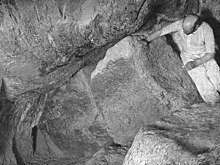
The Ascending Passage connects the Descending Passage to the Grand Gallery. It is 75 cubits or 39.27 metres (128.8 ft) long and of the same width of height as the shaft it originates from (1.20 m (3.9 ft) high, 1.06 m (3.5 ft) wide), although its angle is slightly lower at 26°6'.
The lower end is plugged by three stones of granite, which were slid down from the Grand Gallery to seal the tunnel. They are 1.57 m (5.2 ft), 1.67 m (5.5 ft) and 1 m (3.3 ft) long respectively. The upmost is heavily damaged, hence shorter. The Robbers' Tunnel ends slightly below them. To access the Descending Passage, a hole was dug around them since the surrounding limestone is considerably softer and easier to work.
The joints between the stones of the walls are vertical in the lower third of the corridor, otherwise, they are perpendicular to the floor, apart for three girdle stone inserted near the middle (about 10 cubits apart) presumably to stabilize the tunnel.
Well Shaft and Grotto
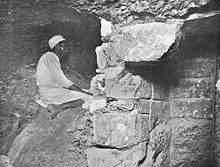
The Well Shaft (also known as the Service-, Air- or Vertical Shaft) links the lower end of the Grand Gallery to the bottom of Descending Passage, about 50 metres (160 ft) further down.
It doesn't take a direct course but changes angle several times. The upper half goes through the nucleus masonry of the pyramid. Vertical at first for 8 metres (26 ft) it then runs slightly angled southwards for about the same distance until it hits bedrock that is circa 5.7 metres (19 ft) above the pyramid's base level at this point. Another vertical section descents further which is partially lined with masonry that has been broken through to a cavity known as the Grotto. The lower half of the Well Shaft goes through the bedrock at an angle of about 45° for 26.5 metres (87 ft) before a steeper section, 9.5 metres (31 ft) long, leads to its lowest point. The final section of 2.6 metres (8.5 ft) connects it to the Descending Passage, running almost horizontal. The builders evidently had trouble aligning the lower exit.
The purpose of the shaft is commonly explained as a ventilation shaft for the Subterranean Chamber and as a flight shaft for the workers who slid the blocking stones of the Ascending Passage into place.
The Grotto is a natural limestone cave, likely filled with sand and gravel before pyramid construction, that was later on hollowed out by looters. A granite block rests in it that likely originated from the portcullis that once sealed the King's Chamber.
Queen's Chamber
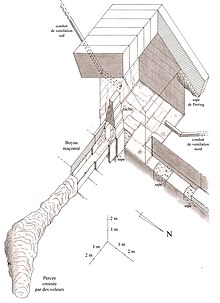
Also at the start of the Grand Gallery, there is the Horizontal Passage leading to the "Queen's Chamber". At start, five pairs of holes suggest the tunnel was once concealed with slabs that laid flush with the gallery floor. The passage is 1.06 metres (3.5 ft) (2 cubits) wide and 1.17 metres (3.8 ft) high for most of its length, but near the chamber there is a step in the floor, after which the passage is 1.68 metres (5.5 ft) high. Half of the west-wall consists of two layers that have atypically continuous vertical joints. Dormion suggests the entrances to magazines laid here, that were filled in.
The "Queen's Chamber" is exactly halfway between the north and south faces of the pyramid. It measures 10 cubits (north-south) by 11 cubits (east-west) or 5.23 metres (17.2 ft) by 5.77 metres (18.9 ft), and has a pointed roof with an apex 12 cubits or 6.26 metres (20.5 ft) above the floor. At the eastern end of the chamber there is a niche 9 cubits or 4.67 metres (15.3 ft) high. The original depth of the niche was 2 cubits or 1.04 metres (3.4 ft), but has since been deepened by treasure hunters.
In the north and south walls of the Queen's Chamber there are shafts which were found in 1872 by a British engineer, Waynman Dixon, who believed shafts similar to those in the King's Chamber must also exist. The shafts were not connected to the outer faces of the pyramid or the Queen's Chamber; their purpose is unknown. In one shaft Dixon discovered a ball of diorite (a type of rock), a bronze hook of unknown purpose and piece of cedar wood. The first two objects are currently in the British Museum. The latter was lost until recently when it was found at the University of Aberdeen. It has since been radiocarbon dated to 3341-3094 BC. The northern shaft's angle of ascent fluctuates and at one point turns 45 degrees to avoid the Great Gallery. The southern is perpendicular to the pyramid's slope
The shafts in the Queen's Chamber were explored in 1993 by the German engineer Rudolf Gantenbrink using a crawler robot he designed, Upuaut 2. After a climb of 65 m (213 ft), he discovered that one of the shafts was blocked by a limestone "door" with two eroded copper "handles". The National Geographic Society created a similar robot which, in September 2002, drilled a small hole in the southern door only to find another stone slab behind it. The northern passage, which was difficult to navigate because of its twists and turns, was also found to be blocked by a slab.
Research continued in 2011 with the Djedi Project which used a fibre-optic "micro snake camera" that could see around corners. With this, they were able to penetrate the first door of the southern shaft through the hole drilled in 2002, and view all the sides of the small chamber behind it. They discovered hieroglyphics written in red paint. Egyptian mathematics researcher Luca Miatello stated that the markings read "121"- the length of the shaft in cubits. The Djedi team were also able to scrutinize the inside of the two copper "handles" embedded in the door which they now believe to be for decorative purposes. They also found the reverse side of the "door" to be finished and polished which suggests that it was not put there just to block the shaft from debris, but rather for a more specific reason.
Grand Gallery
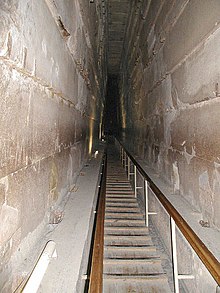
The Grand Gallery continues the slope of the Ascending Passage towards the King's Chamber, extending from the 23rd to the 48th course, a rise of 21 metres (69 ft). It has been praised as a "truly spectacular example of stonemasonry". It is 8.6 metres (28 ft) high and 46.68 metres (153.1 ft) long. The base is 4 cubits or 2.06 metres (6.8 ft) wide, but after two courses (at a height of 2.29 metres (7.5 ft)) the blocks of stone in the walls are corbelled inwards by 6–10 centimetres (2.4–3.9 in) on each side. There are seven of these steps, so, at the top, the Grand Gallery is only 2 cubits or 1.04 metres (3.4 ft) wide. It is roofed by slabs of stone laid at a slightly steeper angle than the floor of the gallery so that each stone fits into a slot cut in the top of the gallery like the teeth of a ratchet. The purpose was to have each block supported by the wall of the Gallery, rather than resting on the block beneath it, in order to prevent cumulative pressure.
At the upper end of the Gallery on the eastern wall, there is a hole near the roof that opens into a short tunnel by which access can be gained to the lowest of the Relieving Chambers.
The floor of the Grand Gallery has a shelf or step on either side, 1 cubit or 51 centimetres (20 in) wide, leaving a lower ramp 2 cubits or 1.04 metres (3.4 ft) wide between them. In the shelves, there are 56 slots, 28 on each side. On each wall, 25 niches have been cut above the slots. The purpose of these slots is not known, but the central gutter in the floor of the Gallery, which is the same width as the Ascending Passage, has led to speculation that the blocking stones were stored in the Grand Gallery and the slots held wooden beams to restrain them from sliding down the passage. Jean-Pierre Houdin theorized that they held a timber frame that was used in combination with a trolley to pull the heavy granite blocks up the pyramid.
At the top of the gallery, there is a step onto a small horizontal platform where a tunnel leads through the Antechamber, which was once blocked by portcullis stones, into the King's Chamber.
The Big Void
In 2017, scientists from the ScanPyramids project discovered a large cavity above the Grand Gallery using muon radiography, which they called the "ScanPyramids Big Void". Key was a research team under Professor Morishima Kunihiro from Nagoya University that used special nuclear emulsion detectors. Its length is at least 30 metres (98 ft) and its cross-section is similar to that of the Grand Gallery. Its existence was confirmed by independent detection with three different technologies: nuclear emulsion films, scintillator hodoscopes, and gas detectors. The purpose of the cavity is unknown and it is not accessible. Zahi Hawass speculates it may have been a gap used in the construction of the Grand Gallery, but the Japanese research team state that the void is completely different from previously identified construction spaces.
To verify and pinpoint the void, a team from Kyushu University, Tohoku University, the University of Tokyo and the Chiba Institute of Technology planned to rescan the structure with a newly developed muon detector in 2020. Their work was delayed by the coronavirus pandemic.
Antechamber
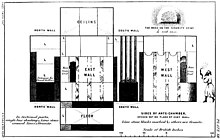
The last line of defense against intrusion was a small chamber specially designed to house portcullis blocking stones, called the Antechamber. It is cased almost entirely in granite and is situated between the upper end of the Grand Gallery and the King's Chamber. Three slots for portcullis stones line the east and west wall of the chamber. Each of them topped with a semi-circular groove for a log, around which ropes could be spanned.
The granite portcullis stones were approximately 1 cubit or 0.52 metres (1.7 ft) thick and were lowered into position by the aforementioned ropes which were tied through a series of four holes at the top of the blocks. A corresponding set of four vertical grooves are on the south wall of the chamber, recesses that make space for the ropes.
The Antechamber has a design flaw: the space above them can accessed, thus all but the last block can be circumvented. This was exploited by looters who punched a hole through the ceiling of the tunnel behind, gaining access to the King's Chamber. Later on all three portcullis stones were broken and removed. Fragments of these blocks can be found in various locations in the pyramid (the Pit Shaft, the Original Entrance, the Grotto and the recess before the Subterranean Chamber).
King's Chamber

The "King's Chamber" is faced entirely with granite and measures 20 cubits (east to west) by 10 cubits (north to south) or 10.47 metres (34.4 ft) by 5.234 metres (17.17 ft).
It has a flat roof 11 cubits and 5 digits or 5.852 metres (19.20 ft) above the floor formed of nine slabs of stone weighing in total about 400 tons. All the roof beams show cracks due to the chamber having settled 2.5 to 5 cm (0.98 to 1.97 in).
The walls consist of five courses of blocks that are uninscribed, as was the norm for burial chambers of the 4th dynasty. The stones are precisely fitted together, the facing surfaces dressed to varying degrees, some displaying remains of bosses not cut away entirely. The back sides of the blocks were only roughly hewn to shape, as was usual with Egyptian hard-stone facade blocks, presumably to save work.
Sarcophagus
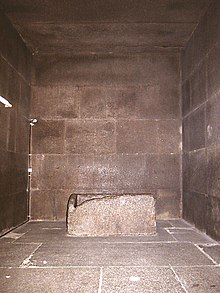
The only object in the King's Chamber is a sarcophagus made out of a single, hollowed-out granite block, which does not contain Khufu's remains. It is of the form common for early Egyptian sarcophagi, rectangular in shape with grooves to slide the now missing lid into place with three small holes for pegs to fixate it. The coffer was not perfectly smoothed, displaying various tool marks matching those of copper saws and tubular hand-drills.
When it was rediscovered in the early middle ages, it was found broken open and any possible content had already been removed.
The internal dimensions are roughly 198 cm (6.50 ft) by 68 cm (2.23 feet), the external 228 cm (7.48 ft) by 98 cm (3.22 ft), with a height of 105 cm (3.44 ft). The walls having a thickness of about 15 cm (0.49 ft).
The sarcophagus is too large to fit around the corner between Ascending- and Descending Passage, which indicates that it must have been placed in the chamber before the roof was put in place.
Air shafts
In the north and south walls of the King's Chamber are two narrow shafts, commonly known as "air shafts". They face each other and are located approximately 0.91 m (3.0 ft) above the floor, 2.5 m (8.2 ft) from the eastern wall, with a width of 18 and 21 cm (7.1 and 8.3 in) and a height of 14 cm (5.5 in). Both start out horizontally for the length of the granite blocks they go through before changing to an upwards direction. The southern ascents at an angle of 45° with a slight curve westwards. One ceiling stone was found to be distinctly unfinished which Gantenbrink called a "Monday morning block". The northern changes angle several times, shifting the path to the west, perhaps to avoid the Big Void. The builders had trouble calculating the right angles, resulting in parts of the shaft being narrower. Nowadays they both communicate to the exterior. If they originally penetrated the outer casing is unknown.
The purpose of these shafts is not clear: They were long believed by Egyptologists to be shafts for ventilation, but this idea has now been widely abandoned in favour of the shafts serving a ritualistic purpose associated with the ascension of the king's spirit to the heavens. Ironically, both shafts have been fitted with ventilators in 1992 to reduce the humidity in the pyramid.
Some people, like Robert Bauval, suggested them to be aligned towards stars or areas of the northern and southern skies, yet the northern follows a dog-leg course through the masonry and the southern has a bend of approximately 20 centimetres (7.9 in), indicating no intention to have them point to any celestial objects.
Relieving Chambers

Above the roof of the King's Chamber are five compartments, named (from lowest up) "Davison's Chamber", "Wellington's Chamber", "Nelson's Chamber", "Lady Arbuthnot's Chamber", and "Campbell's Chamber".
It is believed that they were intended to safeguard the King's Chamber from the possibility of the roof collapsing under the weight of stone above, hence they are commonly referred to as "Relieving Chambers".
The floor of each Relieving Chamber is made up of the same granite blocks that form the roof of the chamber directly below it. The top sides of those blocks were only roughly shaped, giving all five chambers an irregular floor, but a flat ceiling, except the upmost chamber which has a pointed limestone roof.
Nathaniel Davison is credited with the discovery of the lowest of these chambers in 1763, although a French merchant named Maynard informed him of its existence. It can be reached through an ancient passage that originates from the top of the south wall of the Grand Gallery. The upper four chambers were discovered in 1837 by Howard Vyse after a crack in the ceiling of the first chamber, which allowed the insertion of a long reed, was followed upward by forcing a tunnel through the masonry employing gunpowder and boring rods. (Dynamite was not invented until about 30 years later.) They were completely unaccessible until then since construction, no old shaft like that to Davison's Chamber existed.
Numerous graffiti of red Ochre paint were found to cover the limestone walls of all four newly discovered chambers. Apart from leveling lines and indication marks for masons, multiple hieroglyphic inscriptions spell out the names of work-gangs. Those names, which were found in other Egyptian pyramids like that of Menkaure and Sahure as well, usually included the name of the pharaoh they were working for. The blocks must have received the inscriptions before the chambers became inaccessible during construction. Their orientation, often side-ways or upside down, and them being sometimes partially covered by blocks, seems to indicate that the stones were inscribed even before being laid.
The inscriptions, correctly deciphered only decades after discovery, read as follows:
- "The gang, The Horus Mededuw-is-the-purifier-of-the-two-lands." Found once in relieving chamber 3. (Mededuw being Khufu's Horus name.)
- "The gang, The Horus Mededuw-is-pure" Found seven times in chamber 4.
- "The gang, Khufu-excites-love" Found once in chamber 5 (top chamber).
- “The gang, The-white-crown-of Khnumkhuwfuw-is-powerful” Found once in chambers 2 and 3, ten times in chamber 4 and twice in chamber 5. (Khnum-Khufu being Khufu's full birth name.)
Pyramid Complex
See also: Giza pyramid complexThe Great Pyramid is surrounded by a complex of several buildings including small pyramids.
Temples and Causeway
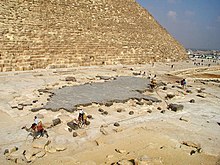
The Pyramid Temple, which stood on the east side of the pyramid and measured 52.2 metres (171 ft) north to south and 40 metres (130 ft) east to west, has almost entirely disappeared apart from the black basalt paving. There are only a few remnants of the causeway which linked the pyramid with the valley and the Valley Temple. The Valley Temple is buried beneath the village of Nazlet el-Samman; basalt paving and limestone walls have been found but the site has not been excavated.
East Cemetery
The tomb of Queen Hetepheres I, sister-wife of Sneferu and mother of Khufu, is located approximately 110 metres (360 ft) east of the Great Pyramid. Discovered by accident by the Reisner expedition, the burial was intact, though the carefully sealed coffin proved to be empty.
Subsidiary Pyramids
On the southern end of the east side are four subsidiary pyramids The three that remain standing to nearly full height are popularly known as the Queens' Pyramids (G1-a, G1-b and G1-c). The fourth, smaller satellite pyramid (G1-d), was so ruined that its existence was not suspected until the first course of stones and later the remains of the capstone were discovered during excavations in 1991-93.
Boats

Three boat-shaped pits are located east of the pyramid. of a size and shape to have held complete boats, though so shallow that any superstructure, if there ever was one, must have been removed or disassembled.
Two additional boat pits, long and rectangular in shape, were found south of the pyramid, still covered with slabs of stone weighing up to 15 tons.
The first of these was discovered in May 1954, the Egyptian archaeologist Kamal el-Mallakh. Inside were 1,224 pieces of wood, the longest 23 metres (75 ft) in length, the shortest 10 centimetres (0.33 ft). These were entrusted to a boat builder, Haj Ahmed Yusuf, who worked out how the pieces fit together. The entire process, including conservation and straightening of the warped wood, took fourteen years. The result is a cedar-wood boat 43.6 metres (143 ft) long, its timbers held together by ropes, which is currently housed in the Giza Solar boat museum, a special boat-shaped, air-conditioned museum beside the pyramid.
During construction of this museum in the 1980s the second sealed boat pit was discovered. It was left unopened until 2011 when excavation began on the boat.
Pyramid Town
A notable construction flanking the Giza pyramid complex is a cyclopean stone wall, the Wall of the Crow. Lehner has discovered a worker's town outside of the wall, otherwise known as "The Lost City", dated by pottery styles, seal impressions, and stratigraphy to have been constructed and occupied sometime during the reigns of Khafre (2520–2494 BC) and Menkaure (2490–2472 BC). In the early 21st century, Mark Lehner and his team made several discoveries, including what appears to have been a thriving port, suggesting the town and associated living quarters, which consisted of barracks called "galleries", may not have been for the pyramid workers after all but rather for the soldiers and sailors who utilized the port. In light of this new discovery, as to where then the pyramid workers may have lived, Lehner suggested the alternative possibility they may have camped on the ramps he believes were used to construct the pyramids or possibly at nearby quarries.
In the early 1970s, the Australian archaeologist Karl Kromer excavated a mound in the South Field of the plateau. This mound contained artefacts including mudbrick seals of Khufu, which he identified with an artisans' settlement. Mudbrick buildings just south of Khufu's Valley Temple contained mud sealings of Khufu and have been suggested to be a settlement serving the cult of Khufu after his death. A worker's cemetery used at least between Khufu's reign and the end of the Fifth Dynasty was discovered south of the Wall of the Crow by Hawass in 1990.
Looting
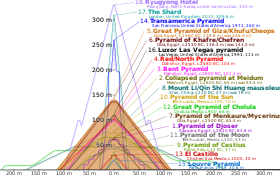
Although succeeding pyramids were smaller, pyramid-building continued until the end of the Middle Kingdom. However, as authors Brier and Hobbs claim, "all the pyramids were robbed" by the New Kingdom, when the construction of royal tombs in a desert valley, now known as the Valley of the Kings, began. Joyce Tyldesley states that the Great Pyramid itself "is known to have been opened and emptied by the Middle Kingdom", before the Arab caliph Al-Ma'mun entered the pyramid around 820 AD.
I. E. S. Edwards discusses Strabo's mention that the pyramid "a little way up one side has a stone that may be taken out, which being raised up there is a sloping passage to the foundations". Edwards suggested that the pyramid was entered by robbers after the end of the Old Kingdom and sealed and then reopened more than once until Strabo's door was added. He adds: "If this highly speculative surmise be correct, it is also necessary to assume either that the existence of the door was forgotten or that the entrance was again blocked with facing stones", in order to explain why al-Ma'mun could not find the entrance.
Herodotus visited Egypt in the 5th century BC and recounts a story that he was told concerning vaults under the pyramid built on an island where the body of Khufu lies. Edwards notes that the pyramid had "almost certainly been opened and its contents plundered long before the time of Herodotus" and that it might have been closed again during the Twenty-sixth Dynasty of Egypt when other monuments were restored. He suggests that the story told to Herodotus could have been the result of almost two centuries of telling and retelling by Pyramid guides.
See also
- Ancient Egypt in mathematics and architecture
- Djedi Project
- Golden ratio in architecture
- Index of Egypt-related articles
- List of archaeoastronomical sites by country
- List of Egyptian pyramids
- List of largest monoliths including a section on calculating the weight of megaliths
- List of tallest freestanding structures
- Pyramid inch
- Pyramidology
- The Upuaut Project
Notes
- Based on side lengths 230.252m, 230.454m, 230.391m, 230.357m.
References
- Verner (2001), p. 189.
- Lehner (1997), p. 108
- Tallet, Pierre (2017). Les Papyrus de la Mer Rouge I: Le Journal de Merer. ISBN 978-2724707069.
- Lehner & Hawass (2017), pp. 143, 530–531
- ^ Lehner (1997), p. 207
- ^ Romer (2007), p. 8. "By themselves, of course, none of these modern labels define the ancient purposes of the architecture they describe."
- Shaw (2003), p. 89
- ^ M. Haase: Eine Stätte für die Ewigkeit. ... Mainz 2004, S. 125.
- Edwards (1986), pp. 990–91
- ^ Diodorus Siculus (1933), p. 216, note 1.
- ^ Herodotus, The Histories 2.124
- Herodotus, The Histories 2.127
- Hawass, Zahi (2007). "The Discovery of the Osiris Shaft at Giza". The Archaeology and Art of Ancient Egypt. 1: 390.
- kmtsesh (18 February 2012). "The Osiris Shaft: a Giza cenotaph". Ancient Near East: Just the Facts. Retrieved 24 October 2019.
- Herodotus, The Histories 2.125
- M. Haase: Eine Stätte für die Ewigkeit. ... Mainz 2004, S. 127.
- Diodorus Siculus, Bibliotheca historica 1.69.
- Shaw & Bloxam (2021), p. 1157
- ^ Diodorus Siculus, Bibliotheca historica 1.63.
- ^ Diodorus Siculus, Bibliotheca historica 1.64.
- Burton (1972), p. 189
- Strabo, Geographica 17.1.34.
- Petrie (1883), p. 217
- Edwards (1986), pp. 99–100
- Maspero (1903), p. 181
- Petrie (1892), pp. 24–25, 167
- ^ Pliny the Elder, Naturalis Historia 36.16-17.
- ^ Pliny the Elder, Naturalis Historia 36.17.
- Lawton & Ogilvie-Herald (2000), p. 189
- Itinerarium Egeriae Y2 ; ed. R. Weber, CCSL 175:100; PL 173:1129D; trans. Wilkinson 1999, 94. This passage is not found in the sole surviving manuscript, which is only partially preserved, but appears in a later work by Peter the Deacon that uses Egeria as a source; see Wilkinson 1999, 4, 86. Wilkinson is confident "this is the first text to mention what became the regular Christian explanation of the pyramids" (94 n. 4); cf. Osborne 1986, 115.
- Historia monachorum in Aegypto 18.3; ed. Preuschen 1897, 79; ed. Festugière 1971, 115; trans. Russell 1980, 102. There is also a Latin version by Rufinus, which includes "additions and alterations appropriate to a man who had seen the places and people for himself and regarded the experience as the most treasured of his life" (Russell 1981, 6). Rufinus seems a little less clear: "There is a tradition that these sites, which they call the storehouses (thesauros) of Joseph, are where Joseph is said to have stored up the grain. Others say it is the Pyramids themselves in which it is thought that the grain was collected" (PL 21:440; ed. Schulz-Flügel 1990, 350).
- Beazley 1897, 73, says "writing in 376"; Nicolet 1991, 96, has "perhaps prior to A.D. 376"; and Brill's New Pauly (Leiden, 2005), s.v. Iulius has "4th/5th cents."
- Cosmographia 45; ed. Riese 1878, 51.2-4 (B); cf. Osborne 1986, 115. The quote appears only in version B of Riese's ed., a revision from late antiquity, and therefore may not derive from Julius.
- Schironi (2009), pp. 119–120
- Tompkins (1971), pp. 6–17
- Colavito (2015), pp. 51–55
- Vyse (1840b), pp. 321–330
- Tompkins (1971), p. 17
- Ibn al-Nadim (1970), p. 846, note 10
- Ibn al-Nadim (1970), pp. 846–847
- Vyse (1840b), pp. 333–334
- Riggs (2017), pp. 37–38
- El Daly (2005), pp. 48–49
- Al-Maqrizi, Al-Khitat, Chapter 40: The Pyramids
- Tompkins (1971), pp. 21–27
- Romer (2007), p. 157
- "The Great Pyramid Quarry « Ancient Egypt Research Associates". Retrieved 21 March 2021.
- Stille, Alexander. "The World's Oldest Papyrus and What It Can Tell Us About the Great Pyramids". Archived from the original on 28 September 2015. Retrieved 27 September 2015.
- Lehner (1997), p. 202
- "Building the Great Pyramid". BBC. 3 February 2006. Archived from the original on 5 February 2009. Retrieved 5 April 2009.
- Lehner (1997), pp. 39, 224
- Romer (2007), pp. 327, 329–337
- Romer (2007), p.
- Smith, Craig B. (June 1999). "Project Management B.C." Civil Engineering Magazine. Vol. 69, no. 6. Archived from the original on 8 June 2007.
- Romer (2007), pp. 164, 165
- Petrie (1883)
- I.E.S. Edwards (1986) . The Pyramids of Egypt. p. 285.
- Cole (1925).
- ^ Lehner (1997), p. 109
- Petrie (1883), p. 125
- ^ Petrie (1883), p. 38
- Lehner (1997), p. 218
- Verner (2003), p. 70
- Petrie (1940), p. 30.
- Rossi (2007), p. .
- "British Museum – Limestone block from the pyramid of Khufu". britishmuseum.org. Archived from the original on 27 July 2014. Retrieved 30 June 2014.
- The History of Mathematics: A Brief Course, by Roger L. Cooke; 2nd Edition; John Wiley & Sons, 2011; ISBN 9781118030240; pp 235-236
- The Pyramid Builder's Handbook; by Derek Hitchins; Lulu; 2010; ISBN 9781445751658; pp 83-84
- Lehner (1997), p. 212-213
- Petrie (1883), p. VII
- Goyon, Georges (1978). Les Rangs d'Assises de la Grande Pyramide.
- Dash, Glen. "The Curious Case of the Great Pyramid's Alternating Course Heights: An Unsolved Mystery" (PDF). Aeragram. 19_1: 20.
- Lucas, Alfred. Ancient Egyptian Mortars.
- Radiocarbon Dates of Old and Middle Kingdom Monuments in Egypt. 1995.
- Clarke & Engelbach (1991), pp. 78–79.
- Stocks (2003), pp. 182–183.
- Dipayan, Jana. Evidence from detailed petrographic examinations of casing stones from the great pyramid of khufu, a natural limestone from tura, and a man-made (Geopolymeric) limestone.
- Petrie (1883), p. 43-44
- Combined High Resolution Laser Scanning and Photogrammetrical Documentation of the Pyramids at Giza. 2005.
- J.P. Lepre (1990). The Egyptian Pyramids: A Comprehensive, Illustrated Reference. p. 66.
- Jánosi, Peter (1992). Das Pyramidion der Pyramide G III-a. Bemerkungen zu den Pyramidenspitzen des Alten Reiches.
- Lehner, Mark (2005). "Labor and the Pyramids: The Heit el-Ghurab "Workers Town" at Giza". International Scholars Conference on Ancient Near Eastern Economies. 5: 465.
- Dash, Glen. The Man Who Put the Mast Atop the Great Pyramid.
- ^ Maragioglio & Rinaldi, 1965. L'Architettura delle Piramidi Menfite 4, Tavoli.
{{cite book}}:|first=has numeric name (help) - Haase (2004), p. 15
- "The Hieroglyphic Inscription Above the Great Pyramid's Entrance".
{{cite web}}: CS1 maint: url-status (link) - "#ScanPyramids –First conclusive findings with muography on Khufu Pyramid" (PDF).
{{cite news}}: CS1 maint: url-status (link) - "ScanPyramids 2019 English Video Report".
{{cite web}}: CS1 maint: url-status (link) - Tyldesley (2007), pp. 38–40
- ^ Tyldesley (2007), p. 38
- Battutah (2002), p. 18.
- Cooperson, Michael (2010). "al-Ma'mun, the Pyramids, and the Hieroglyphs". In Nawas, John (ed.). Occasional Papers of the School of 'Abbasid Studies Leuven 28 June – 1 July 2004. Orientalia Lovaniensia analecta. Vol. 177. Leuven, Belgium: Peeters. pp. 165–190. OCLC 788203355.
- Dormion (2004), p. 284
- Edgar & Edgar (1910), p. 141
- Maragioglio & Rinaldi (1965), p. 30
- ^ Perring (1839), p. 3, Plate IX
- Vyse (1840b), p. 290
- Vyse (1840a), p. 223-224
- Petrie (1883), p. 60
- Edgar & Edgar (1910), p. 147
- "Unfinished Chamber". Public Broadcasting Service. Archived from the original on 7 August 2008. Retrieved 11 August 2008.
- ^ Dormion (2004), p. 286
- Maragioglio & Rinaldi (1965), p. 114-115
- ^ Haase (2004)
- Dormion (2004), p. 119-124
- Dormion (2004), p. 259
- Dormion (2004), p. 154
- Sharma & Pahuja (2017), p. 38.
- ^ "Lower Northern Shaft". The Upuaut Project. Archived from the original on 29 July 2010. Retrieved 11 October 2010.
- "Great Pyramid: Lost Egyptian artefact found in Aberdeen cigar box". BBC News. 16 December 2020.
- "Will the Great Pyramid's Secret Doors Be Opened?". Fox News. 12 December 2011. Archived from the original on 12 February 2012.
- Gupton, Nancy (4 April 2003). "Ancient Egyptian Chambers Explored". National Geographic. Archived from the original on 3 August 2008. Retrieved 11 August 2008.
- "Third "Door" Found in Great Pyramid". National Geographic. 23 September 2002. Archived from the original on 27 July 2008. Retrieved 11 August 2008.
- https://www.nbcnews.com/id/wbna43314221
- "First images from Great Pyramid's chamber of secrets". New Scientist. Reed Business Information. 25 May 2011. Archived from the original on 6 January 2013. Retrieved 25 December 2012.
- Smith, Craig B. (2018). How the Great Pyramid Was Built. Smithsonian Institution. ISBN 9781588346261.
- Kingsland (1932), p. 71.
- Lehner, Mark (1998). "Niches, Slots, Grooves and Stains: Internal Frameworks in the Khufu Pyramid?". STATIONEN: Beiträge zur Kulturgeschichte Ägyptens: 101–114.
- Lehner (1997), p. 113
- http://en.nagoya-u.ac.jp/research/activities/news/2017/11/Physicists-at-Nagoya-University-discover-a-huge-void-in-Giza's-Great-Pyramid.html
- http://www.aip.nagoya-u.ac.jp/en/public/nu_research/features/detail/0004136.html
- "Mysterious Void Discovered in Egypt's Great Pyramid". 2 November 2017. Archived from the original on 27 July 2018. Retrieved 2 November 2017.
- Morishima, Kunihiro; Kuno, Mitsuaki; Nishio, Akira; Kitagawa, Nobuko; et al. (2 November 2017). "Discovery of a big void in Khufu's Pyramid by observation of cosmic-ray muons". Nature. 552 (7685): 386–390. arXiv:1711.01576. Bibcode:2017Natur.552..386M. doi:10.1038/nature24647. PMID 29160306. S2CID 4459597.
- "Scientists discover hidden chamber in Egypt's Great Pyramid". ABC News. Archived from the original on 2 November 2017. Retrieved 2 November 2017.
- "Critics: Nothing special about big void found in Khufu Pyramid:The Asahi Shimbun". Archived from the original on 8 November 2017. Retrieved 8 November 2017.
- "The Hidden Chamber at Giza to be re-scanned and pinpointed". Retrieved 15 January 2020.
- https://www.express.co.uk/news/world/1346220/egypt-great-pyramid-giza-discovery-hidden-chamber-scanpyramid-pharaoh-khufu-japan-spt
- Maragioglio & Rinaldi (1965), p. 48
- KANAWATI (2005). Decoration of Burial Chambers, Sarcophagi and Coffins in the Old Kingdom.
- Maragioglio & Rinaldi (1965), p. 48
- Lehner (1994). Notes and Photographs on the West-Schoch Sphinx Hypothesis.
- Petrie (1883), p. 84
- Maragioglio & Rinaldi (1965), p. 50
- Stocks (2003).
- Maragioglio & Rinaldi (1965), p. 52
- Dormion (2004), p. 296
- ^ Gantenbrink. "The Upuaut Project". Archived from the original on August 2020.
{{cite web}}: Check date values in:|archive-date=(help) - Jackson & Stamp (2002), pp. 79, 104
- Bauval (1989), p. 17
- ^ Maragioglio & Rinaldi (1965), p. 24
- Vyse (1840b), p. 180
- Vyse (1840a), p. 155, 203pp
- "How Ancient Egyptians Organized their Labor Force" (PDF). pp. 11–13.
{{cite web}}: CS1 maint: url-status (link) - ^ Reisner (1931). Mycerinus: The Temples of the Third Pyramid at Giza. pp. 275, Plan XI, XII.
- Perring (1839), Plates V-VII.
- Arnold (2005), pp. 51–52.
- Arnold, Strudwick & Strudwick (2002), p. 126.
- Callender (1990). Queen Hetepheres I. p. 26.
- "Digital Giza | "The Satellite Pyramid of Khufu"". giza.fas.harvard.edu. Retrieved 24 March 2021.
- "Khufu's Second Boat". Institute of Egyptology. Tokyo: Waseda University. Archived from the original on 11 November 2012. Retrieved 26 December 2012.
- "Wall of the Crow". The Lost City. AERA – Ancient Egypt Research Associates. Archived from the original on 3 May 2019. Retrieved 13 August 2019.
- "The Lost City of the Pyramids". The Lost City. AERA – Ancient Egypt Research Associates. Archived from the original on 13 November 2010. Retrieved 21 October 2010.
- "Dating the Lost City". The Lost City. AERA – Ancient Egypt Research Associates. Archived from the original on 14 November 2010. Retrieved 21 October 2010.
- "Ruins of Bustling Port Unearthed at Egypt's Giza Pyramids". Livescience.com. 28 January 2014. Archived from the original on 3 October 2014. Retrieved 21 August 2014.
- Hawass, Zahi (1999). "Giza, workmen's community". In Kathryn A. Bard (ed.). Encyclopedia of the Archaeology of Ancient Egypt. London/New York. pp. 423–426. ISBN 0-415-18589-0.
{{cite book}}: CS1 maint: location missing publisher (link) - Hawass & Senussi (2008), pp. 127–128.
- Hawass, Zahi. "The Discovery of the Tombs of the Pyramid Builders at Giza". Archived from the original on 1 November 2010. Retrieved 21 October 2010.
- Brier & Hobbs (1999), p. 164.
- Cremin (2007), p. 96.
- Edwards (1986), pp. 99–100
- Edwards (1986), pp. 990–91
Bibliography
- Arnold, Dieter (2005). Temples of Ancient Egypt. I. B. Tauris. ISBN 978-1-85043-945-5.
- Arnold, Dieter; Strudwick, Nigel; Strudwick, Helen (2002). The encyclopaedia of ancient Egyptian architecture. I.B. Tauris. ISBN 978-1-86064-465-8.
- Bauval, Robert G. (1989). "A Master Plan for the Three Pyramids of Giza Based on the Configuration of the Three Stars of the Belt of Orion". Discussions in Egyptology. 13 (7): 7–18.
- Battutah, Ibn (2002). The Travels of Ibn Battutah. London: Picador. ISBN 978-0-330-41879-9.
- Brier, Bob; Hobbs, A. Hoyt (1999). Daily Life of the Ancient Egyptians. Greenwood Press. ISBN 978-0-313-30313-5.
- Burton, Anne (1972). Diodorus Siculus: Book I, A Commentary. Leiden, Netherlands: Brill. ISBN 9004035141.
- Cole, J.H. (1925). Determination of the Exact Size and Orientation of the Great Pyramid of Giza. Cairo: Government Press. SURVEY OF EGYPT Paper No. 39.
- Clarke, Somers; Engelbach, Reginal (1991). Ancient Egyptian construction and architecture. Dover Publications. ISBN 978-0-486-26485-1.
- Collins, Dana M. (2001). The Oxford Encyclopedia of Ancient Egypt. Oxford University Press. ISBN 978-0-19-510234-5.
- Colavito, Jason (2015). Foundations of Atlantis, Ancient Astronauts and Other Alternative Pasts: 148 Documents Cited by Writers of Fringe History, Translated with Annotations. McFarland. ISBN 978-0-7864-9645-7.
- Cremin, Aedeen (2007). Archaeologica: The World's Most Significant Sites and Cultural Treasures. Frances Lincoln. ISBN 978-0-7112-2822-1.
- Diodorus Siculus (1933). Library of History:Books 1-2.34. Vol. 1. Translated by C. H. Oldfather. Cambridge, MA: Harvard University Press.
- Dormion, Gilles (2004). La chambre de Chéops: Analyse architecturale. ISBN 978-2213622293.
- Edgar, John; Edgar, Morton (1910). The Great Pyramid Passages and Chambers. Vol. 1.
- Edwards, I.E.S. (1986) . The Pyramids of Egypt. Max Parrish.
- El Daly, Okasha (2005). Egyptology: The Missing Millennium : Ancient Egypt in Medieval Arabic Writings. Psychology Press. ISBN 978-1-84472-063-7. Retrieved 27 March 2021.
- Greaves, John (1752). Pyramidographia: or, a Description of the pyramids in Egypt. Retrieved 7 April 2021.
- Haase, Michael (2004). "Der Serviceschacht der Cheops-Pyramide. Bemerkungen zur Konstruktion des Verbindungsschachtes zwischen Großer Galerie und absteigendem Korridor". Sokar. 9: 12–17. ISSN 1438-7956.
- Hassan, Selim (1960). Excavations at Gîza 10: 1938-39. The Great Pyramid of Khufu and its Mortuary Chapel. Retrieved 7 April 2021.
- Hawass, Zahi; Senussi, Ashraf (2008). Old Kingdom Pottery from Giza. Supreme Council of Antiquities. ISBN 978-977-305-986-6.
- Ibn al-Nadim (1970). The Fihrist of al-Nadim: a tenth-century survey of muslim culture. Bayard Dodge (trans.). New York City, NY: Columbia University Press.
- Jackson, K.; Stamp, J. (2002). Pyramid : Beyond Imagination. Inside the Great Pyramid of Giza. BBC Worldwide Ltd. ISBN 978-0-563-48803-3.
- Kingsland, William (1932). The Great pyramid in fact and in theory. London: Rider. ISBN 978-0-7873-0497-3.
- Lawton, Ian; Ogilvie-Herald, Chris (2000). Giza: The Truth : the People, Politics and History Behind the World's Most Famous Archaeological Site. Virgin. ISBN 978-0-7535-0412-3. Retrieved 27 March 2021.
- Lehner, Mark (1997). The Complete Pyramids. London: Thames and Hudson. ISBN 0-500-05084-8.
- Lehner, Mark; Hawass, Zahi (2017). Giza and the Pyramids: The Definitive History. University of Chicago Press. ISBN 978-0-226-42569-6.
- Maragioglio, Vito; Rinaldi, Celeste (1965). L'Architettura delle Piramidi Menfite 4. Le Grande Piramide di Cheope (Text - English/Italian). Tipografia Canessa.
- Maragioglio, Vito; Rinaldi, Celeste (1965b). L'Architettura delle Piramidi Menfite 4. Le Grande Piramide di Cheope (Plates). Tipografia Canessa.
- Maspero, Gaston (1903). Sayce, A. H. (ed.). History of Egypt, Chaldea, Syria, Babylonia, and Assyria. Vol. 2. Translated by McClure, M. L. The Grolier Society.
- Perring, John Shae (1839). The pyramids of Gizeh: from actual survey and admeasurement: The great pyramid. Vol. 1.
- Petrie, William Matthew Flinders (1883). The Pyramids and Temples of Gizeh. Field & Tuer. ISBN 0-7103-0709-8.
- Petrie, William Matthew Flinders (1892). Ten Years' Digging in Egypt, 1881-1891. London: Religious Tract Society.
- Petrie, William Matthew Flinders (1940). Wisdom of the Egyptians. British school of archaeology in Egypt and B. Quaritch Limited.
- Pliny the Elder (1855). The Natural History. Translated by Bostock, John; Riley, H. T. London: Taylor and Francis. Retrieved 25 February 2021.
- Riggs, Christina (2017). Egypt: Lost Civilizations. London: Reaktion Books. ISBN 978-1-78023-774-9.
- Romer, John (2007). The Great Pyramid: Ancient Egypt Revisited. Cambridge: Cambridge University Press. ISBN 978-0-521-87166-2.
- Rossi, Corina (2007). Architecture and Mathematics in Ancient Egypt. Cambridge University Press. ISBN 978-0-521-69053-9.
- Schironi, Francesca (2009). From Alexandria to Babylon: Near Eastern Languages and Hellenistic Erudition in the Oxyrhynchus Glossary (P.Oxy. 1802 + 4812). Berlin: Walter de Gruyter. ISBN 978-3-11-021540-3.
- Sharma, Sehdev; Pahuja, Damanjit Kaur (2017). Five Great Civilizations of Ancient World. Educreation Publishing. ISBN 978-1-61813-837-8.
- Shaw, Ian (2003). The Oxford History of Ancient Egypt. Oxford University Press. ISBN 0-19-815034-2.
- Shaw, Ian; Bloxam, Elizabeth, eds. (2021). The Oxford Handbook of Egyptology. Oxford, UK: Oxford University Press. ISBN 9780199271870.
- Smith, Philip (1873). A History of the Ancient World. Vol. 1 (4 ed.). London: John Murray.
- Stocks, Denys Allen (2003). Experiments in Egyptian archaeology: stoneworking technology in ancient Egypt. Routledge. ISBN 978-0-415-30664-5.
- Tallet, Pierre (2017). Les Papyrus de la Mer Rouge I: Le Journal de Merer (Mifao) (Arabic, English and French Edition). ISBN 978-2724707069.
- Tompkins, Peter (1971). Secrets of the Great Pyramid. New York City, NY: Harper & Row.
- Tyldesley, Joyce (2007). Egypt: How a lost civilization was rediscovered. BBC Books. ISBN 978-0-563-52257-7.
- Verner, Miroslav (2001). The Pyramids: The Mystery, Culture, and Science of Egypt's Great Monuments. Grove Press. ISBN 0-8021-1703-1.
- Verner, Miroslav (2003). The Pyramids: Their Archaeology and History. Atlantic Books. ISBN 1-84354-171-8.
- Vyse, H. (1840a). Operations Carried on at the Pyramids of Gizeh in 1837: With an Account of a Voyage into Upper Egypt, and an Appendix. Vol. I. London: J. Fraser. Retrieved 15 September 2014.
- Vyse, H. (1840b). Operations Carried on at the Pyramids of Gizeh in 1837: With an Account of a Voyage into Upper Egypt, and an Appendix. Vol. II. London: J. Fraser. Retrieved 26 February 2021.
Further reading
- Bauval, Robert; Hancock, Graham (1996). Keeper of Genesis. Mandarin books. ISBN 0-7493-2196-2.
- Calter, Paul A. (2008). Squaring the Circle: Geometry in Art and Architecture. Key College Publishing. ISBN 978-1-930190-82-5.
- Clayton, Peter A. (1994). Chronicle of the Pharaohs. Thames & Hudson. ISBN 0-500-05074-0.
- Cooper, Roscoe; Cooper, Vicki Teague; Croll, Carolyn; Patch, Diana Craig; Tehon, Atha (1997). The Great Pyramid: An Interactive Book. London: British Museum Press.
- Der Manuelian, Peter (2017). Digital Giza: Visualizing the Pyramids. Cambridge, MA: Harvard University Press.
- Gahlin, Lucia (2003). Myths and Mythology of Ancient Egypt. Anness Publishing Ltd. ISBN 1-84215-831-7.
- Hassan, Selim (1960). The Great Pyramid of Khufu and its Mortuary Chapel With Names and Titles of Vols. I–X of the Excavations at Giza (PDF). Ministry of Culture and National Orientation, Antiquities Department of Egypt. Archived from the original (PDF) on 29 January 2013.
- Hawass, Zahi A. (2006). Mountains of the Pharaohs: The Untold Story of the Pyramid Builders. Cairo: American University in Cairo Press.
- Hawass, Zahi (2015). Magic of the Pyramids: My adventures in Archeology (in Arabic). Leonardo Paolo Lovari. ISBN 978-88-98301-33-1. Retrieved 27 March 2021.
- Levy, Janey (2005). The Great Pyramid of Giza: Measuring Length, Area, Volume, and Angles. Rosen Publishing Group. ISBN 1-4042-6059-5.
- Lepre, J.P. (1990). The Egyptian Pyramids: A Comprehensive, Illustrated Reference. McFarland & Company. ISBN 0-89950-461-2.
- Lightbody, David I (2008). Egyptian Tomb Architecture: The Archaeological Facts of Pharaonic Circular Symbolism. British Archaeological Reports International Series S1852. ISBN 978-1-4073-0339-0.
- Nell, Erin; Ruggles, Clive (2014). "The Orientations of the Giza Pyramids and Associated Structures". Journal for the History of Astronomy. 45 (3): 304–360. arXiv:1302.5622. Bibcode:2014JHA....45..304N. doi:10.1177/0021828614533065. S2CID 119224474.
- Oakes, Lorana; Lucia Gahlin (2002). Ancient Egypt. Hermes House. ISBN 1-84309-429-0.
- Petrie, W.M. Flinders (2006). The Pyramids and Temples of Gizeh. Worcester, UK: Yare Egyptology.
- Rossi, Corinna; Accomazzo, Laura (2005). The Pyramids and the Sphinx (English ed.). Cairo: American University in Cairo Press.
- Scarre, Chris (1999). The Seventy Wonders of the Ancient World. Thames & Hudson, London. ISBN 978-0-500-05096-5.
- Seidelmann, P. Kenneth (1992). Explanatory Supplement to the Astronomical Almanac. University Science Books. ISBN 0-935702-68-7.
- Siliotti, Alberto (1997). Guide to the pyramids of Egypt; preface by Zahi Hawass. Barnes & Noble Books. ISBN 0-7607-0763-4.
- Smyth, Piazzi (1978). The Great Pyramid. Crown Publishers Inc. ISBN 0-517-26403-X.
- Wirsching, Armin (2009). Die Pyramiden von Giza – Mathematik in Stein gebaut (2nd ed.). Books on Demand. ISBN 978-3-8370-2355-8.
External links
Library resources aboutGreat Pyramid of Giza
- Template:Curlie
- Building the Khufu Pyramid
- "The Giza Plateau Mapping Project". Oriental Institute.
 Geographic data related to Great Pyramid of Giza at OpenStreetMap
Geographic data related to Great Pyramid of Giza at OpenStreetMap
| Records | ||
|---|---|---|
| Preceded byRed Pyramid | World's tallest structure c. 2570 BC − 1300 AD 146.6 m |
Succeeded byLincoln Cathedral |
Note: Spire of Lincoln Cathedral, versus other possible medieval cathedral spires (like Lincoln's, all since destroyed), is an item of debate amongst experts. Feel free to see List of tallest buildings and structures#History and Lincoln Cathedral for more information.
| Egyptian pyramids | |||||||||
|---|---|---|---|---|---|---|---|---|---|
| |||||||||
| Old Kingdom (2686–2181 BC) |
| ||||||||
| 1 Intermediate Period (2181–2040 BC) |
| ||||||||
| Middle Kingdom (2040–1650 BC) |
| ||||||||
| Second Intermediate (1650–1570 BC) |
| ||||||||
| New Kingdom (1570–1070 BC) |
| ||||||||
| Memphis and the Memphis pyramid complex | ||
|---|---|---|
| City | 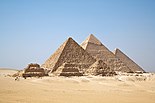 | |
| Abu Rawash | ||
| Giza | ||
| Zawyet el'Aryan | ||
| Abusir | ||
| Saqqara | ||
| Dahshur | ||
| Mazghuna | ||
| See also | ||
| Seven Wonders of the Ancient World | |
|---|---|
| The Seven Wonders | |
| Related | |
| Giza | |
|---|---|
| History | |
| Geography | |
| Districts | |
| Landmarks | |
| Education | |
